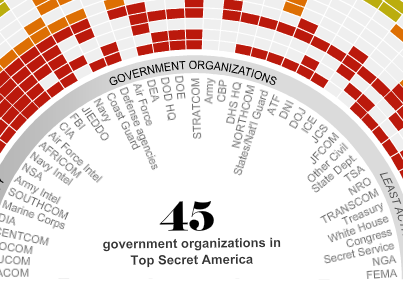The Intelligence Edifice: Too Big To Succeed
The Intelligence Edifice: Too Big To Succeed

A tantalizing Twitter from @Wikileaks went up on Saturday morning: “Real change begins Monday in the WashPost. By the years end, a reformation. Lights on. Rats out.”
The series to which they referred, “Top Secret America,” by Dana Priest and William Arkin, began today and is certainly a barn-burner. It features an enormous database detailing the thousands of complex connections between private business and the evidently-misnamed intelligence community. The story has been tearing up the Internets all day long, even though Priest and Arkin don’t really reveal much that we didn’t already know, or at least that we didn’t suspect: the government is a mess! 9/11 persuaded everyone that we ought to throw every available dollar into “fighting” the “terrorists,” which somehow translates into reading everyone’s email and forcing you to pour shampoo into tiny bottles every time you want to get on an airplane!
Ka-ching for “security” companies all round, as every bit of information that can be vacuumed up is recorded eight times and then dumped into a dozen different computer systems that can’t talk to each other! The government’s secret intelligence-gathering has cratered into a bottomless pit of wasteful, pointless, expensive makework that is not making Americans any safer, but is instead reaping huge profits for the herds of greedy contractors who aid them in recording so much information that nobody will ever in a million years find the few bits that might ever have been of any use.
And we kind of knew this part, too, but the scale of the intelligence ramp-up in the last decade really is astounding:
The Pentagon’s Defense Intelligence Agency, for example, has gone from 7,500 employees in 2002 to 16,500 today. The budget of the National Security Agency, which conducts electronic eavesdropping, doubled. Thirty-five FBI Joint Terrorism Task Forces became 106. It was phenomenal growth that began almost as soon as the Sept. 11 attacks ended.
It’s the detail that clinches the deal, here. The amount of work that went into the preparation of the story is monumental. A volvelle-like chart breaks out the top-secret work done by each agency; the searchable database names nearly 2,000 companies involved in top-secret work, and furnishes the locations of over 10,000 locations all over the country where such work is performed. My favorite one is this!
In Elkridge, Md., a clandestine program hides in a tall concrete structure fitted with false windows to look like a normal office building.
Someone please explain this to me. It’s an office building cleverly designed to look like an office building? It’s that there are no real windows, I suppose, so that Jason Bourne won’t be able to get a look in.
Emptywheel and Rayne over at Firedoglake have already got spectacular analysis of Top Secret America.
I’ve got a ton of respect for Priest’s reporting and therefore would guess that the article is designed to reveal the truth about the IC and DoD. And yet the intelligence community, inside its bunker, perceives a search for the truth as a design to portray it unfavorably.
What an apt explanation, then, for the problem with excessive contracting: when a reporter avails herself of Constitutionally protected rights to act as a watchdog on our government and its contractors, the government itself assumes that must be an attack. Hell, the IC has had time to preemptively respond to some of the problems Priest is about to reveal (and, as I said, Shorrock gave them a head start two years ago). [That would be Tim Shorrock, author of Spies for Hire.]
But note, too, that the military itself has had ample time and opportunity to deal with the issue of scale. Recall that last November the House Oversight Committee requested a head count of contractors and subcontractors from Defense Secretary Robert Gates, giving him 30 days to provide the numbers.
It does not appear that this information has yet been furnished, nearly eight months later. If it has, it’s not been widely reported. And we already knew that there were extremely large variances between contractor numbers reported by different groups.
The situation makes for a lot of interesting questions:
o Why is ODNI squirming about revelations from WaPo’s Priest, but not the Pentagon?
o Why aren’t the contractor/subcontractor numbers being disseminated widely?
o How many of the intelligence contractors aren’t actually contracted by CIA but by DIA?
o Just how many of these intelligence contractors are not only working in Iraq and Afghanistan, but in places the American public at large doesn’t think of as threats — like Central and South America?
o And how many of them are in Pakistan — intel or military — in which local sources report a very large complex rivaling the U.S. embassy in Baghdad is being built and guarded by private security contractors?
I’ve got two questions myself. One is, what was the exact role of Wikileaks, if any, in helping the Post reporters gather their material? Their coy Saturday tweet wasn’t the first word on Priest’s project; Marc Ambinder, The Raw Story and others noted on Friday the panic among intelligence officials rising in advance of Monday’s Post. But I’ve noticed that @Wikileaks doesn’t seem to comment much on stories they’ve not been involved in themselves.
My second question is, will the rats really leave, just because someone turned the lights on? Seriously, how are they to be removed? I hope that prediction is accurate, but these aren’t ordinary rats, one feels compelled to observe. These are like, rats with billion-dollar defense contracts. Rats at an infinite trough of hot bread that just keeps right on comin’.
Maria Bustillos is the author of Dorkismo: The Macho of the Dork and
